Cosmetics Marketing & Industry Trends:
A 2020 Ecommerce Report on the State of Online Beauty

by Reilly Roberts
Apr. 16 2020
Long controlled by a handful of legacy brands with majority market share, the tide has turned. Today, DTC cosmetics is one of the fastest-growing consumer product categories in the world.
Entrepreneurs rush to greet a new generation of young consumers seeking fresh and creative products.
Clinging to enterprise status, large-scale manufactures respond by acquiring their independent, trendier counterparts.
Will the bottom fall out anytime soon?
Beauty begs to differ.
Data, trends, and strategies — straight from the top incumbent and DTC brands — give insight into the future of the cosmetics industry:
DON’T MISS THAT LAST SECTION …
There you’ll find detailed examples — packed with tactics and lessons — from three fast-growing ecommerce companies …
ColourPop
In a competitive market, this indie beauty brand stood out against expensive rivals with creative that highlighted product quality. The payoff?
5x return on prospecting campaigns, 7.5x return on remarketing efforts, and 15x return on its social campaigns made in collaboration with Disney.
Coola
As a brand that wasn’t digitally native, the eco-conscious retailer’s hurdle was gaining traffic online. By selling through product funnels using Facebook advertising, it offered customers the niche products they actually needed.
Conversions increased, repeat customers lifted +50%, and the brand hit 140% year-over-year growth.
Bambu Earth
Struggling with low traffic and dismal conversion rate that no new creative or better-performing ad could fix — this clean-beauty brand needed a refresh. Its lifeline came in the form of an online “Skin Quiz,” powerhouse UGC, and insights from customers seeded throughout the funnel.
The results? 25x revenue YoY, 2.5x AOV, and profitability for the first time.
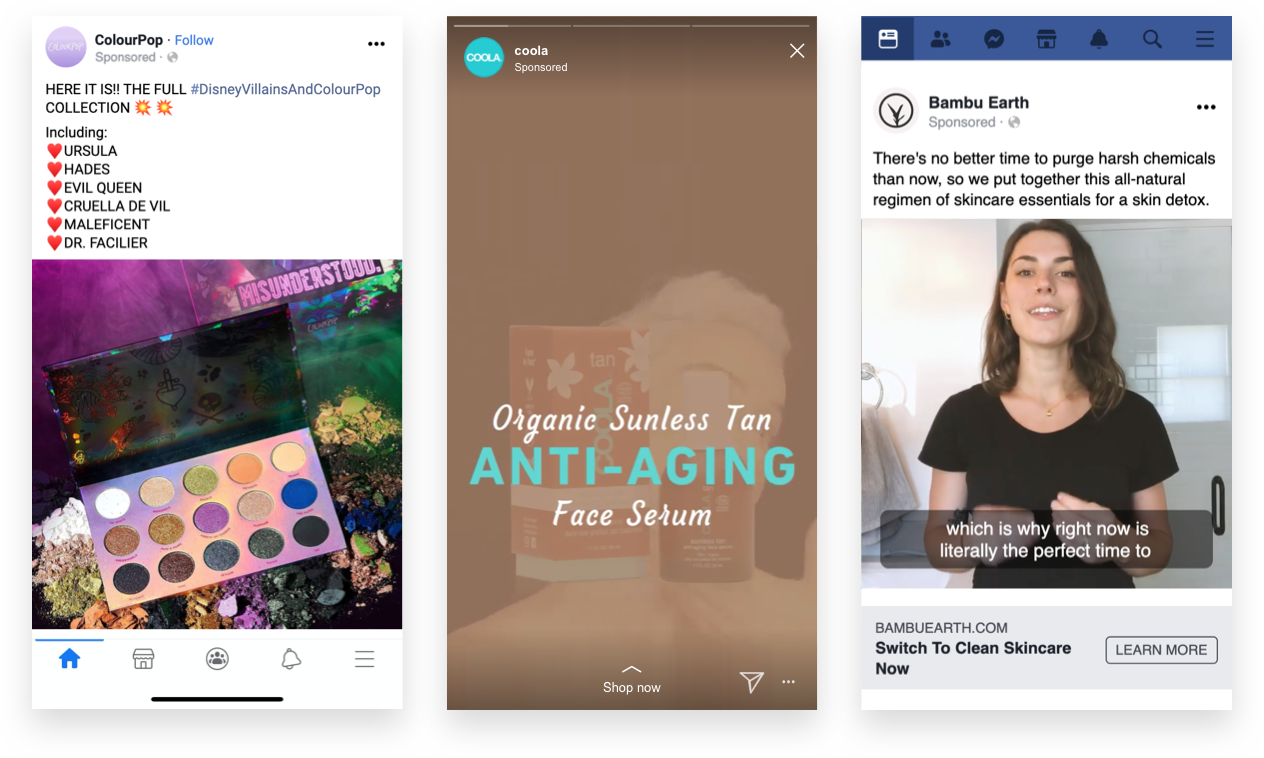
Cosmetics Industry: Data, Market Share, and Growth
For the purpose of this report, we’re dividing the umbrella of “beauty” into three main business segments: skincare, color cosmetic make-up, and fragrance.
Though split up into different verticals, they are complementary in the sense that they play a holistic role in consumer’s personal cosmetics routines.
Beauty Industry Statistics and Market Research: Global & US
Globally, the industry is strong and only getting stronger — predicted to exceed $716B by 2025. The kindling: expansion of cosmetics marketing through digital channels and the ensuing attraction of more customers willing to pay higher prices for higher quality.
Those looking to enter new markets, should. As emerging nations grow in purchasing power and become globalized, they offer budding promise for international companies to enter — if they bring higher quality products than those available locally along with them.
By geography, Asia-Pacific and North America dominated, accounting for more than 60% of the cosmetics market combined.

With shopping preferences differing from county-to-country, cosmetics brands looking to rule on a global scale must follow a customer-centric model that intersects both digital and physical channels.
In the case of the US, offline shopping still rules — luring a whopping 81% of the market in-stores. At the same time, offline’s market share is also declining while online climbs.
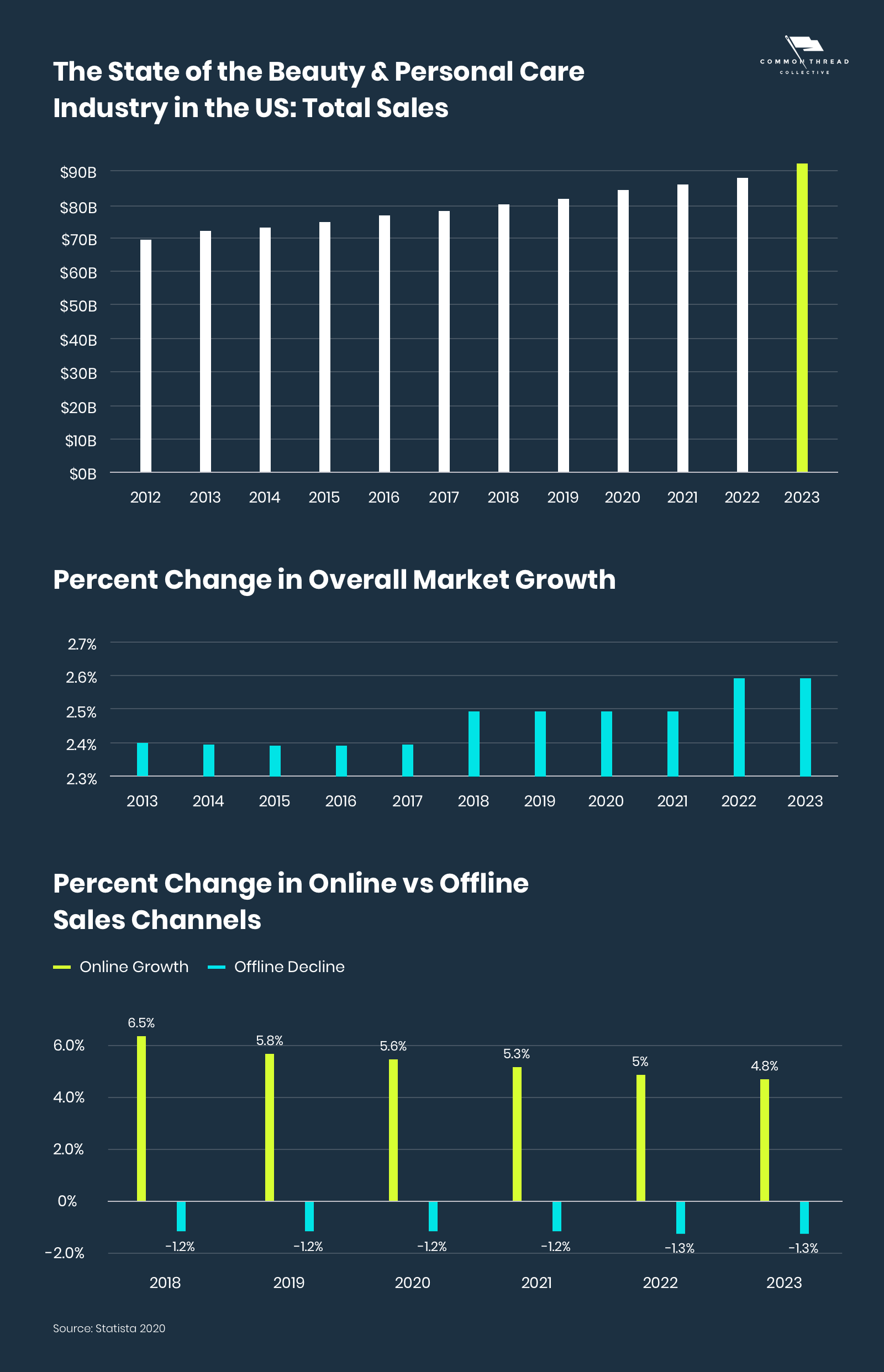
The US was even considered the most valuable beauty and personal care market in the world in 2018. Starting the trends and then setting the standards for other countries to follow suit.
Though the distribution methods are evolving, traditional retail chains still play the largest role in the US.

Aside from multi-brand conglomerates like Walmart and Target, the biggest vertical-specific players are Ulta and Sephora — the leading health and beauty retailers based on sales.
The same holds true on a worldwide scale.
For more than a century, production of cosmetics and beauty products has been controlled by a handful of multinational corporations. The long-reigning legacies — L’Oréal, Unilever, Procter & Gamble, and Estee Lauder Companies — made up a whopping 81.7% of worldwide beauty revenue in 2019. Leaving little behind to spare.
In the US, all hopes turn to ecommerce.

Although ecommerce penetration has only increased slightly in recent years, the beauty and personal care online share is predicted to surge to 48% in the United States by 2023.
While promising, mass-merchandiser and multi-brand platforms currently have a stranglehold on the market.
But, ecommerce offers something legacy retailers do not: exclusivity.
The way into the winner’s club unites that desire for convenience with quality products.
eMarketer reports that the beauty buyers who valued quality most were more likely to shop directly from a cosmetics brand’s site (64%), while big-box stores won shoppers on price (28%).
This difference in quality is the brand-differentiator that will make or break an ecommerce beauty brand.
Tired of scrolling? Want to save the report for later or share with your team?
Good news. You can.
We’ve compiled as the data, tactics, and case studies into a single — and fittingly beautiful — PDF. No strings attached …

Trends & Verticals: Insight from the Top Beauty Brands
Each vertical can be differentiated further, both by distribution channel and brand. Cosmetics occupy a unique segment as they’re available in a wide range of retail locations — from luxury spas and department stores to home-television shopping and airport vending machines.
According to a 2018 survey from Pymnts, the most important factor influencing consumer behavior in the US beauty market — beyond price or location — were special sales, unique products, and rewards programs.
Brands can lean into these ecommerce trends with the exclusivity of the online shopping experience to challenge the upper-hand of in-store retailers.
Beyond channels, there’s another divisive trend within the industry — natural cosmetics.
Because of rising incomes, consumers are more considerate of both product effectiveness and ingredients rather than price. As a result, retailers are more focused on advertising the quality of products as better than competitors, instead of undercutting prices.
To win in the fight over product superiority comes from the marketing use of three little words: natural, organic, or clean.
In fact, the cosmetics industry has the biggest share of consumers that prefer to shop organic. But, “clean beauty” and “organic makeup” are more than just buzzwords.
The global market value for natural cosmetics expected nearly a 2x increase from 2018 to roughly 54.5 billion dollars expected for the year 2027 — proof of the growing importance of the natural and organic cosmetics market.

The division lies within the definition. To be considered natural, the product must meet non-toxic standards for ingredients and processing.
Since there isn’t strict regulation on the natural beauty market, the disparity between private standards and administrative interpretations leaves open a potentially dangerous loophole for consumers.
With all the smoke and mirrors, insecurity throughout the cosmetic industry ensues over what actually constitutes natural beauty.
Upstarts that want to dominate the competitive arena should look to build an authentic and sustainable model.
As consumers become increasingly wary of potential toxicity in cosmetics, Statista reports that market segments offering fragrance-free products made using natural ingredients and essential oils are likely to record strong growth in the future.
Cosmetics, Beauty Products by Market Share and Growth
Across product categories, skincare made up 40% of the global cosmetic market in 2019.
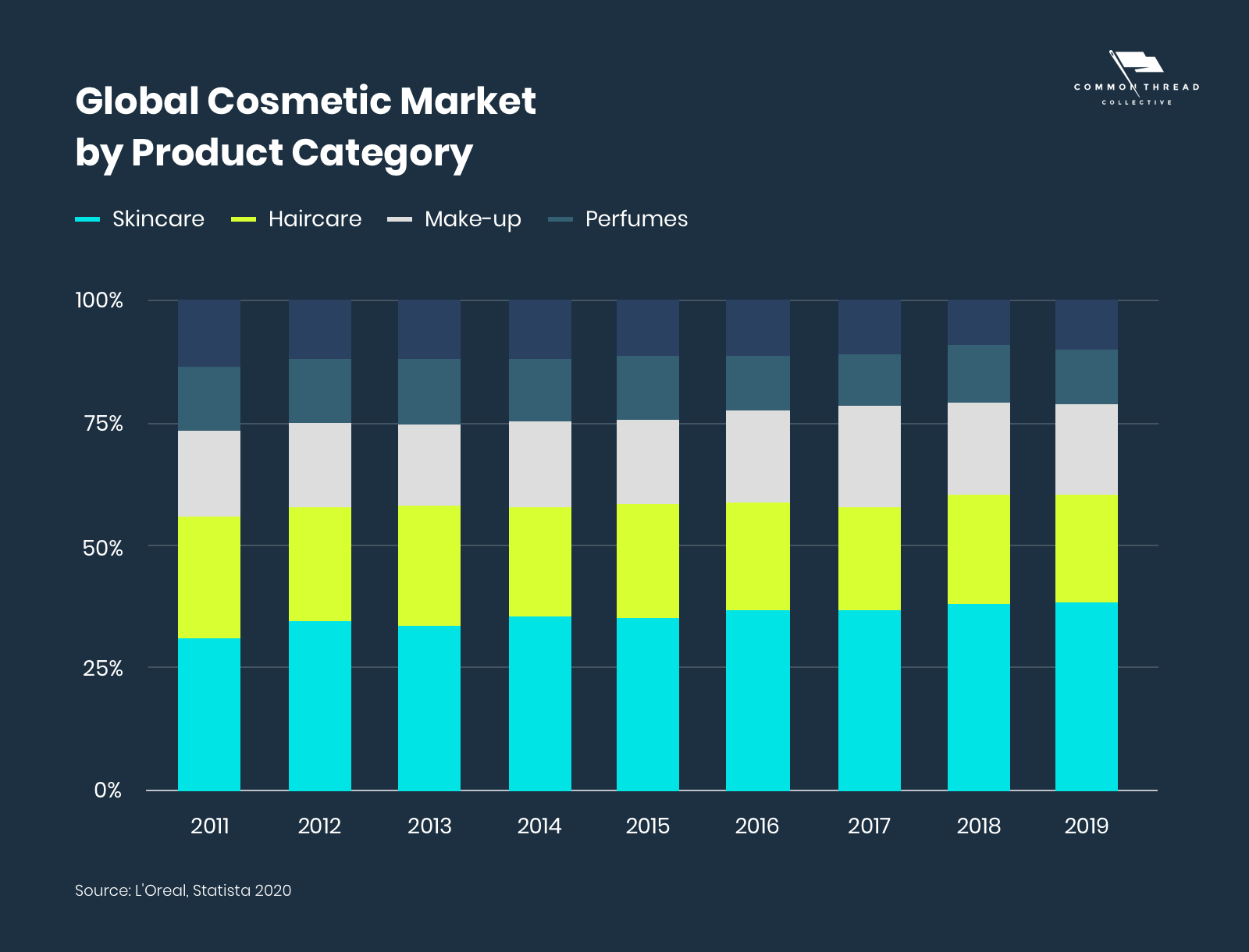
It follows that this trend will continue as consumers become more educated about sun damage — indicating potential for growth within the subcategories of sun protection and anti-aging skincare products.
In the same vein, cosmetics brands that meet consumer’s new demands and expectation levels of quality will experience growth.
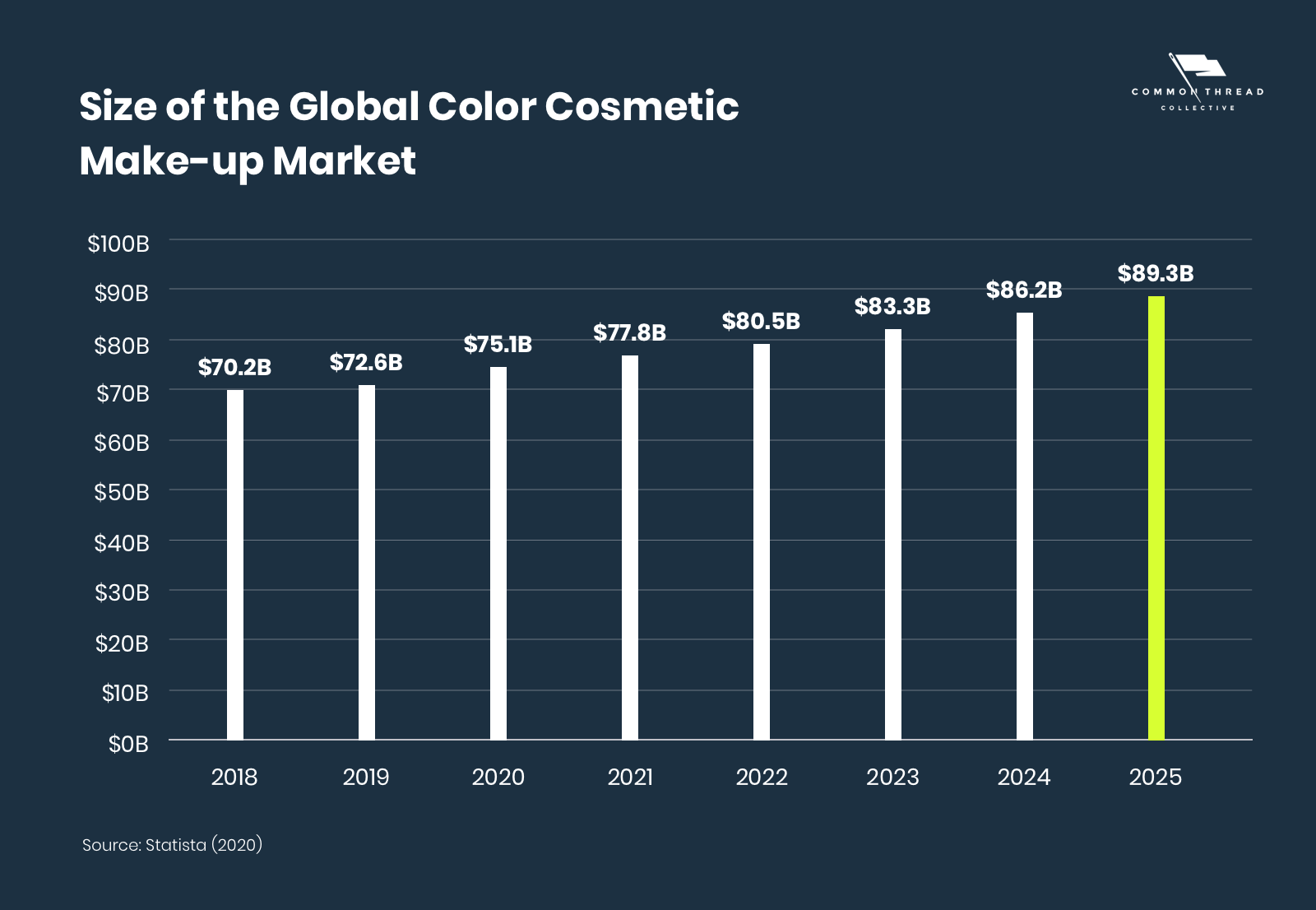
While the beauty and personal care industry will remain strong globally, the cosmetics and skincare verticals specifically will experience the most revenue growth in the US at a rate of 3.5% by 2021.
Demographics of Beauty
As non-western countries climb in purchasing power, their influence on demographics follow. With ethnicity, culture, and rituals different from North America and Europe, diversity shapes the broader global market in its image.
Variety is now the norm.
“It’s not enough to make 50 shades of foundation and only sell the dark ones online,” said beauty influencer Jackia Aina in a 2019 interview. “I’ve directly seen how the consumers have demanded better and fairer retail shopping experiences for everyone … we’ve seen a big rise in brands expanding on their products.”
Ethnicity isn’t the only driver, age plays a critical role in how consumers shop for personal care products.
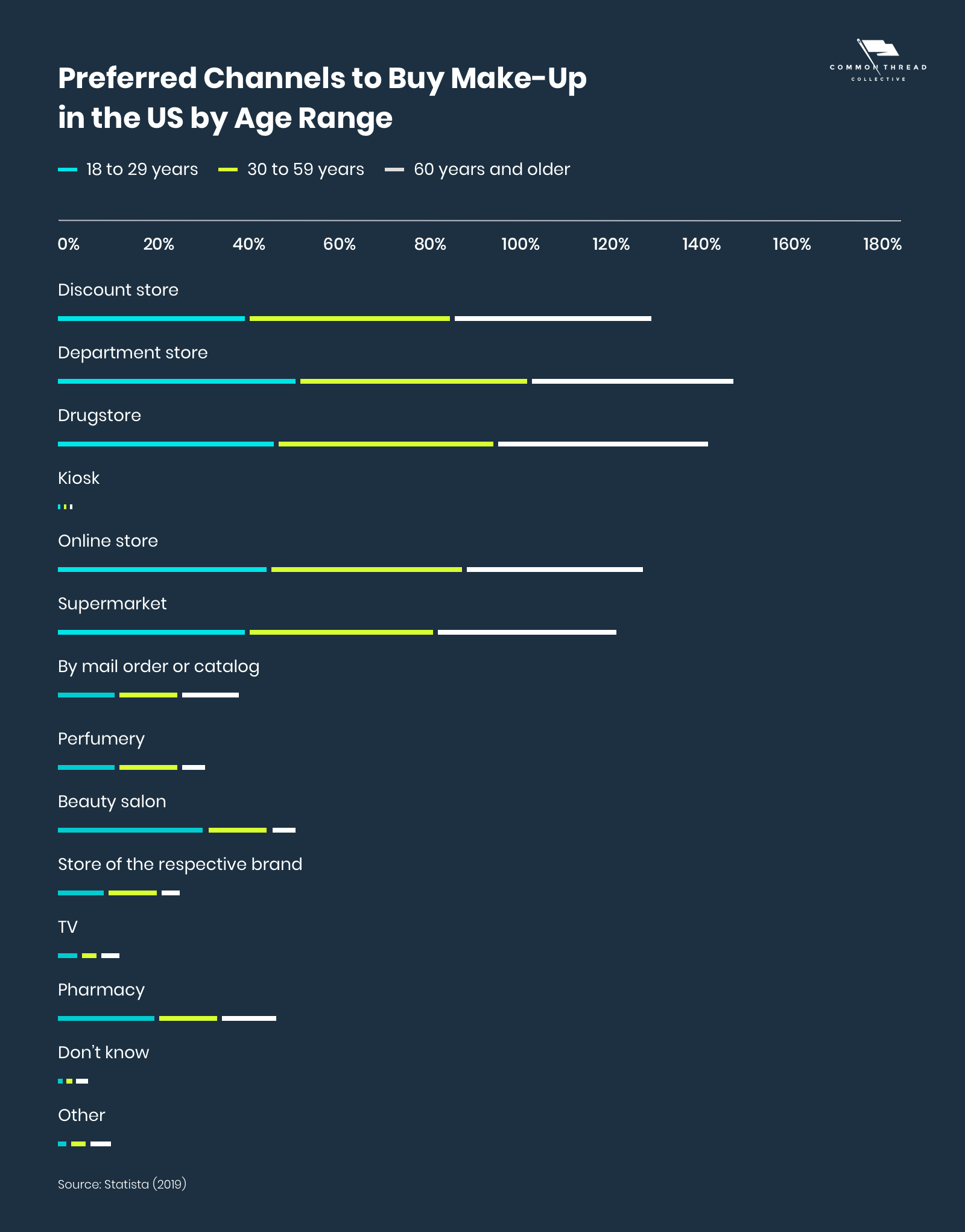
As a result of entering the job market, millennials and Gen Z have become the biggest drivers of the cosmetics business. This is especially glaring in the US, where they have above-average expenditures on personal care products — an index of 122 on cosmetic products — compared to other shoppers.
Of the leading make-up purchase criteria according to women in the US — the importance of quality, value, and the brand remained relatively similar across all age-groups.
Among millennials, in particular, were significant differences.
They more than doubled their baby boomer counterparts in regard to preference for organic or eco-friendliness.
Even more striking, 29% of them make purchasing decisions based on media or online reviews — 3x greater than that of Gen X’ers and a whopping 6x more than Baby Boomers.

This sets the stage for social proof as the key to unlock for millennials’ loyalty and trust. Both socially native brands and ecommerce retailers are therefore in prime position to capture their market share.
Which, of course, brings us to …
Amazon
Amazon’s success in yet another CPG category is no surprise. According to Edison Trends data, health and beauty was the third-most-purchased category on the Amazon in 2018.
Though not the largest percentage of its revenue on platform, in the grander scheme, Amazon accounts for 44.3% of total retail ecommerce sales of health, personal care, and beauty products in the US.
In the first quarter of 2018, Amazon’s cosmetics category sales increased by 20% compared to the previous year. Especially noteworthy was that derma skincare category sales increased 84% during the measured period.
Though Walmart is chasing after, Amazon remains far in the lead in terms of onsite user experience.
A majority of consumers cite the convenience of Amazon’s website, easy navigation, and service as the main reasons they choose Amazon over Walmart for beauty purchases.
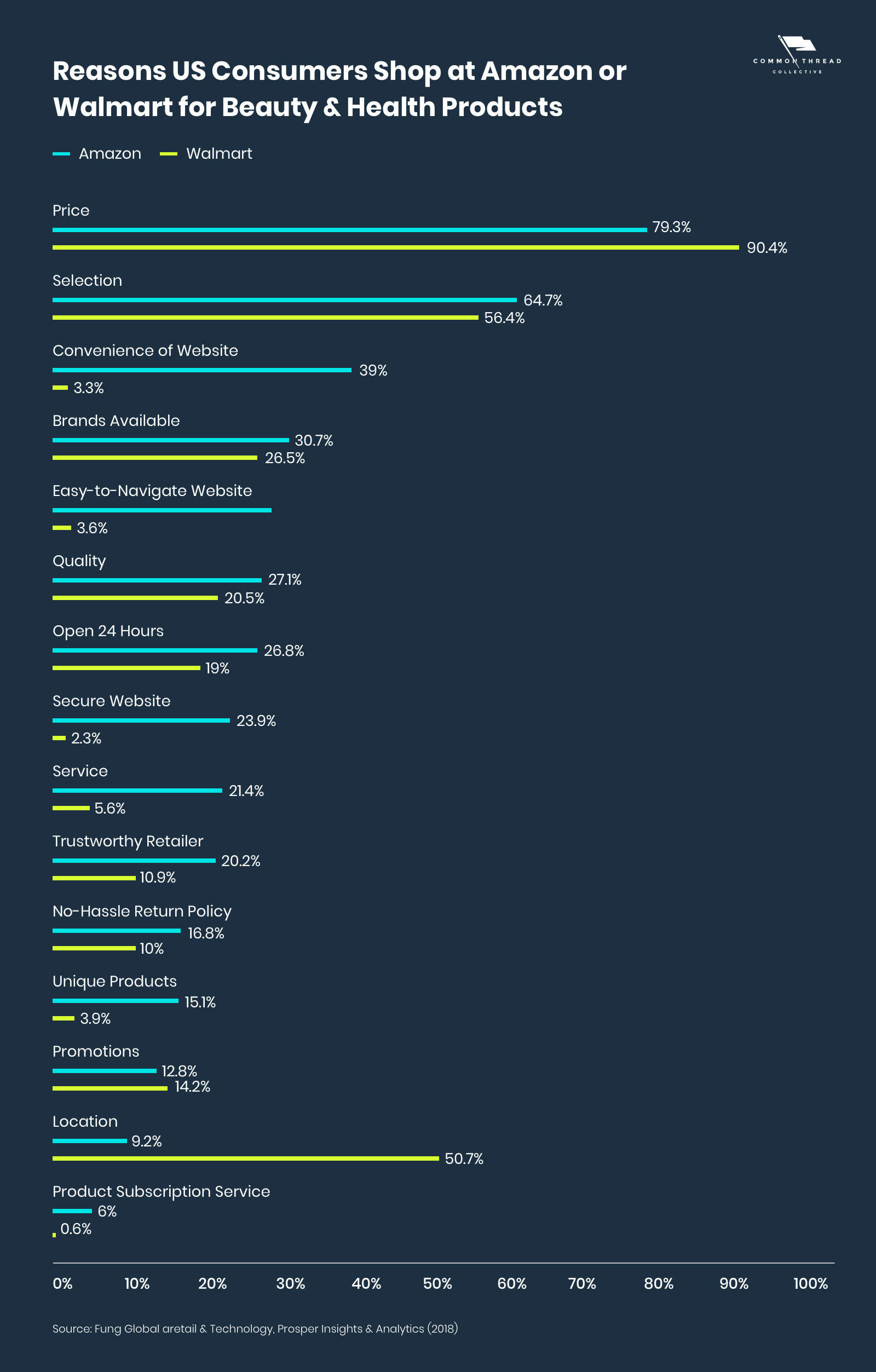
This is also bolstered by its Prime membership program. According to eMarketer, 52.5% of Prime members had bought beauty products in the past 12 months vs. 16.9% of nonmembers.
Although Amazon’s health and beauty sales are growing, cosmetics shoppers still prefer other channels. Beauty retailer, Ulta, has far higher ecommerce sales ($618.8 billion) and just 10.1% of Ulta’s total revenues come from digital channels.
It’s a glimmer of hope for retailers not selling on the platform, that Amazon isn’t always the end-all-be-all.
Top Beauty & Cosmetics Brands & 5 Trends
Legacy: Top 10
Leading the market for more than a century, legacy cosmetics brands dominate on a global scale.
Since 81% of all US consumers shop in-stores, their longstanding product placements in brick-and-mortar beauty retailers and drugstore chains are especially lucrative.
Meet, the old guard:

Despite their longstanding success, brand loyalists have grown old, and to succeed in the future at the same scale means attracting Gen Z and millennials.
Call it karma — the legacy retailers who preached that youth is beauty, are now being pushed out by younger brand counterparts …
Direct-to-Consumer: Top 10-20
The old guard of makeup brands — like L’Oréal, Estée Lauder, and Chanel — though revered for their revenue and legacy, aren’t revered by all.
As a new generation of consumers grows up, they’re more empowered to purchase “quick-to-market” products found via social media from brands that are growing right alongside them.
Enter, the new guard courtesy of 2PM Inc.’s DNVB Power List:
- Kylie Cosmetics
- Birchbox
- Drunk Elephant
- Oars & Alps
- Clark’s Botanicals
- Glossier
- Morphe
- Goop
- Fenty Beauty
- Curology
- The Honest Company
- Kopari Beauty
- Supergoop!
- MILK Makeup
- Peach & Lily
- True Botanicals
- Volition Beauty
- Tula
- Necessaire
- Winky Lux
The rise of social shopping coupled with more consumer packaged goods offerings online, lends itself to new ecommerce penetration opportunities for DTC brands.
What’s more, beauty products make up the second-largest product category for engagement across Instagram, Twitter, and Facebook.

“It’s not just the billion-dollar brands like Kylie Cosmetics and Glossier,” said Andrew Lipsman, eMarketer principal analyst in a 2019 report.
“There’s a whole cottage industry of emerging direct-to-consumer brands in the beauty and personal care space that are leveraging targeted social ads and influencer marketing to accelerate growth.”
As it stands, more than half of US internet users have already purchased from DTC personal care and beauty brands in the past:
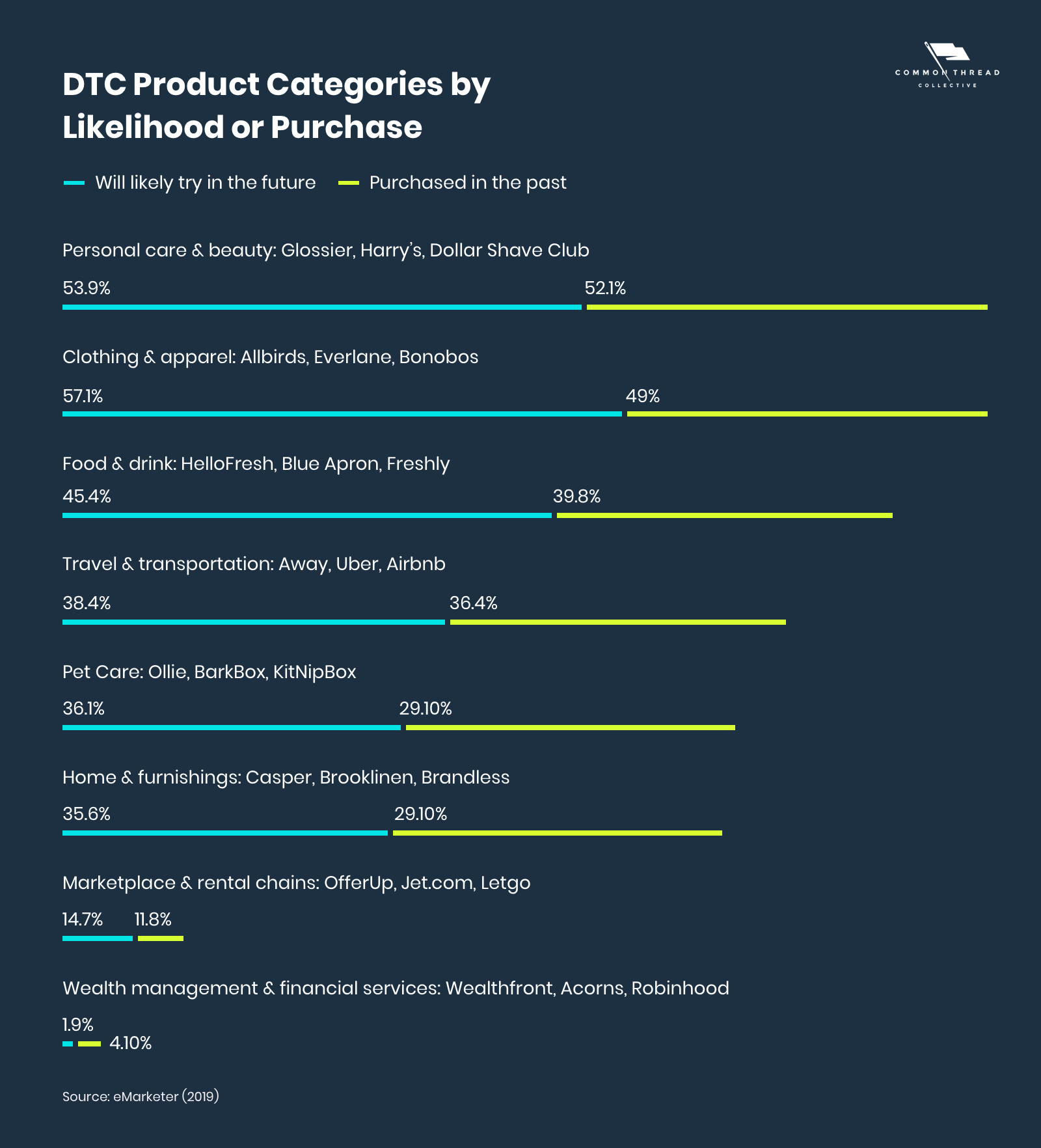
Even more promising, 53.9% said they will likely try products from DTC’s in the beauty industry going forward in 2019.
Cosmetic Industry Trends
The DTCs bring new creativity, while the legacies bring wisdom. There’s a lesson to be learned from each …
1. BIRCHBOX & IPSY: SUBSCRIPTION SERVICES
In the past several years, subscription startups like Birchbox and Ipsy have reached valuations ranging from $500 million to $2 billion — with investors encouraged by the belief that they’d grow quickly because they had a recurring revenue stream.
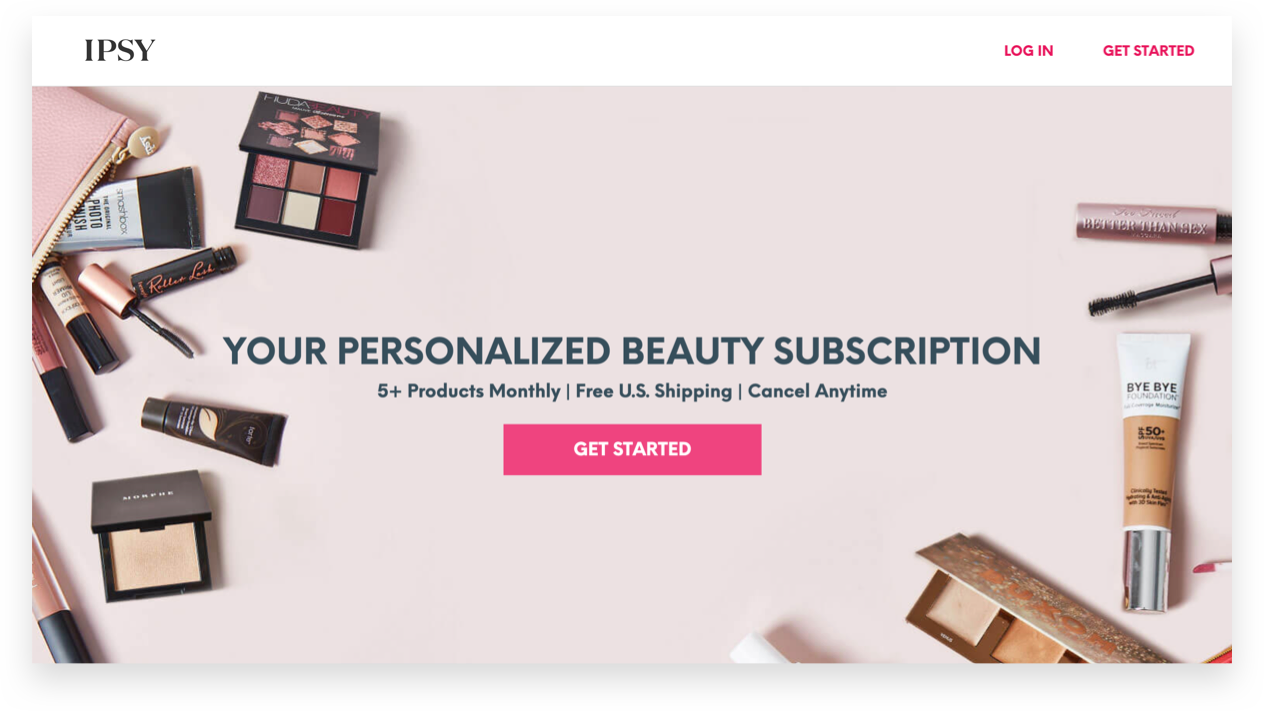
Pioneers of the subscription economy, Birchbox and Ipsy solved for the problem of product discovery — adding elements of delight and convenience.
Despite a strong start, by 2018 less than 10% of US internet users had received a subscription box in the past month (eMarketer).
It also proved difficult to keep profitable, as many customers would sample products through their subscription boxes, but ultimately buy the full-sized items from retail giants rather than the startup’s site.

2. GLOSSIER: POP-UPS
As a DTC brand that rejects the traditional brick-and-mortar model, it follows that Glossier’s entry into the retail space rejects the norm.
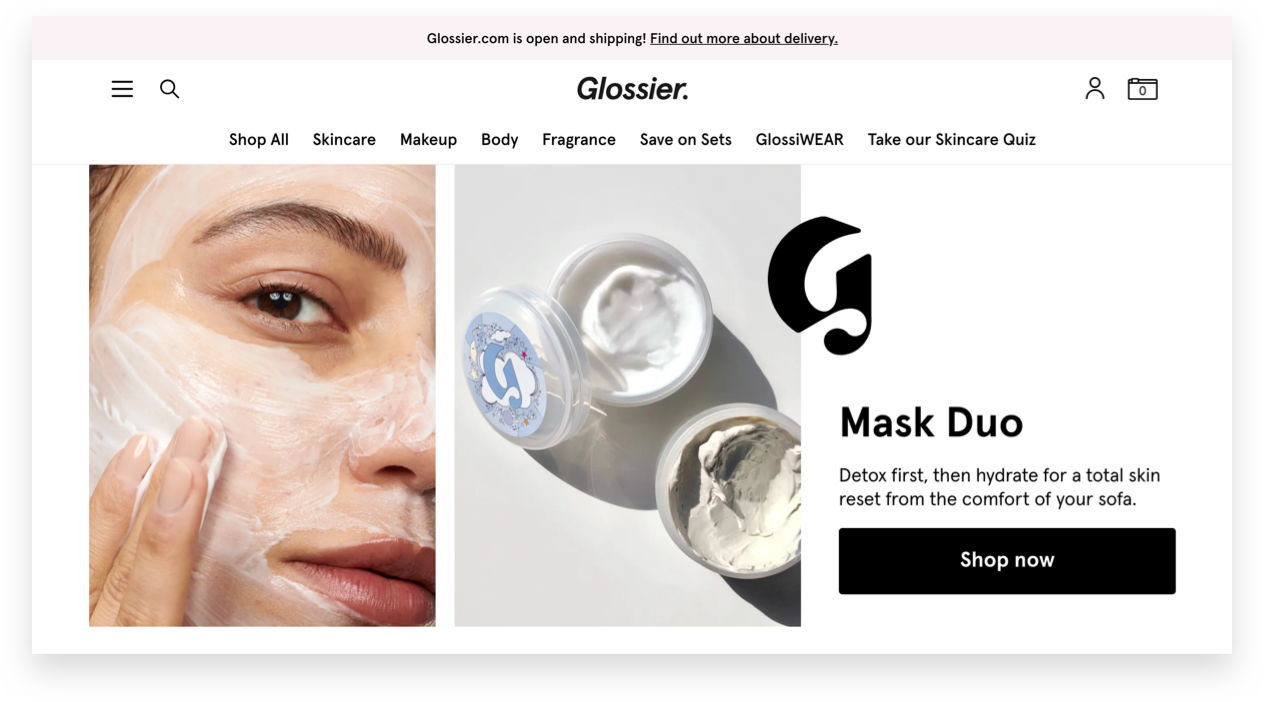
Experience-led and cult-followed, Glossier seasonally opens exclusive pop-up stores from Los Angeles to London. But, the store experience is anything but typical.
With different themes in each space and experiential marketing activations — it’s built hype that attracts droves of brand enthusiasts eager to try out the products in real-time.
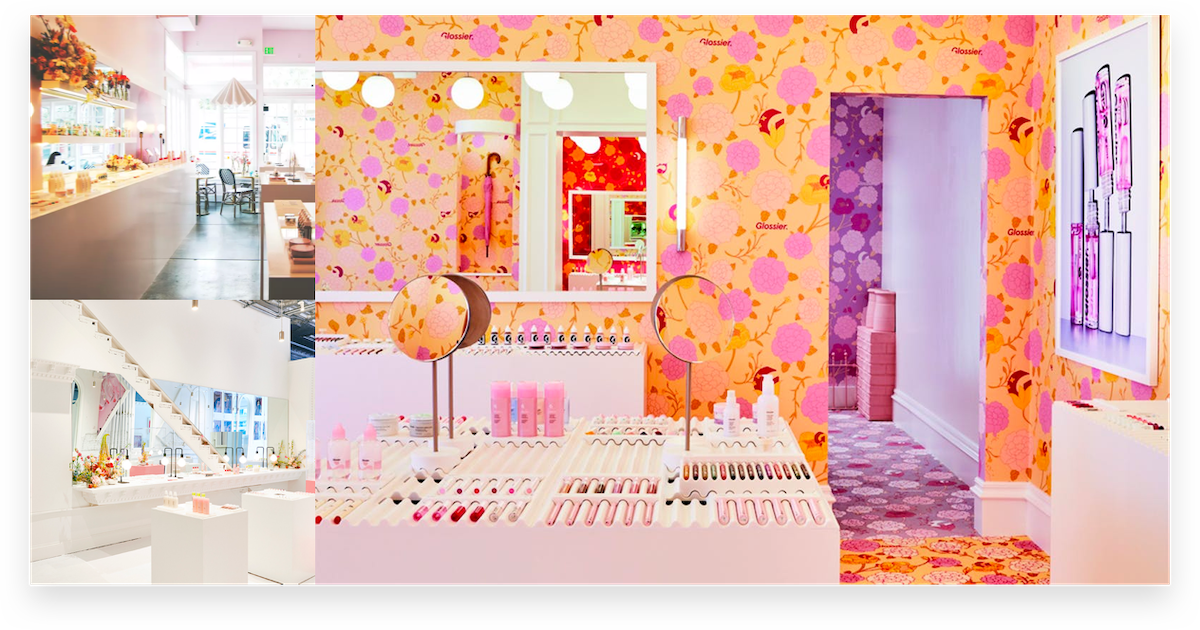
By engaging with its fans in a face-to-face setting, Glossier is able to deepen relationships with customers beyond online interactions. Yet, it doesn’t come with the financial obligations of following a chain-store model.
Instead, the pop-up model allows them to reap the benefits of a physical presence to capture consumer demand without the real estate costs.
However, brands looking to imitate its model should first be cognizant of who their own consumer is.
eMarketer reports that 38% of customers interested in checking out pop-up stores are those who already shop online every week compared to 28% who prefer brick-and-mortar shopping.
Thus, the appeal of pop-ups may work best to draw in the digitally inclined shopper, rather than the latter.
3. FENTY BY RIHANNA: DIVERSITY, EMBRACED
A product catalog that features foundation in a groundbreaking 40 shades. Marketing campaigns highlighting people of color. Authentic social media messaging.
Every piece of Fenty’s business strategy is derived from a singular mission, “Beauty for all.”
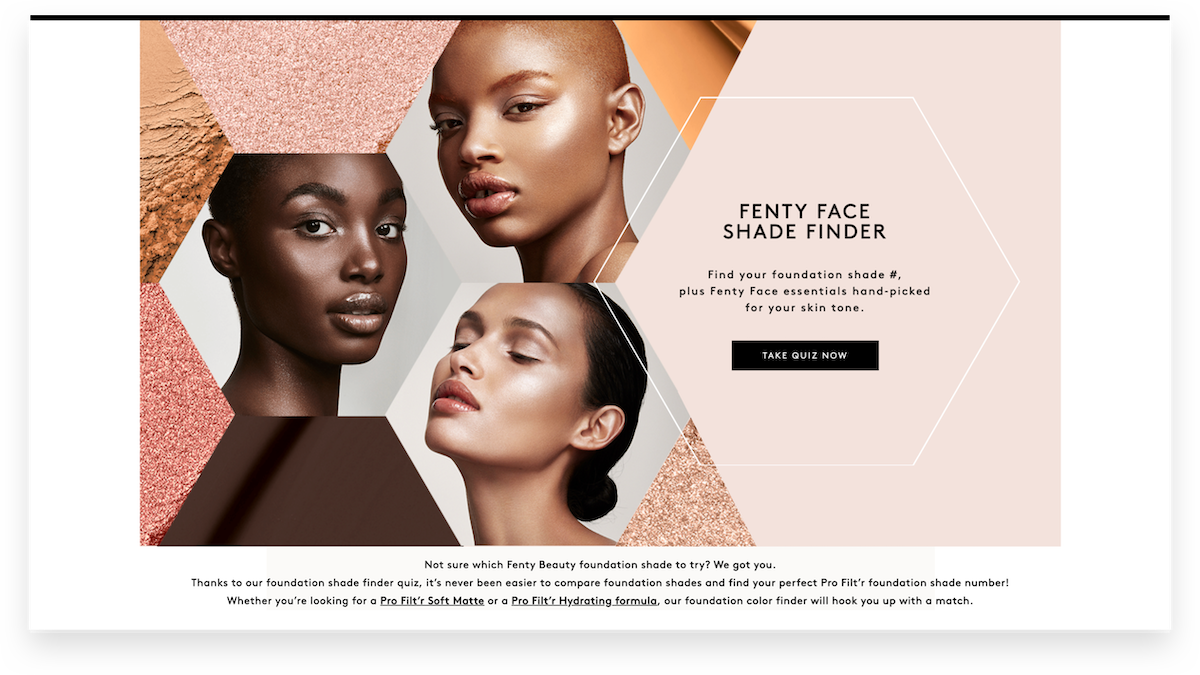
With a lack of diversity in the cosmetic industry, both in representation and product offerings, Fenty was proactive in creating for customers’ needs, not reactive.
“I never could have anticipated the emotional connection that women are having with the products and the brand as a whole,” Rihanna told Time. “Some are finding their shade of foundation for the first time, getting emotional at the counter. That’s something I will never get over.”
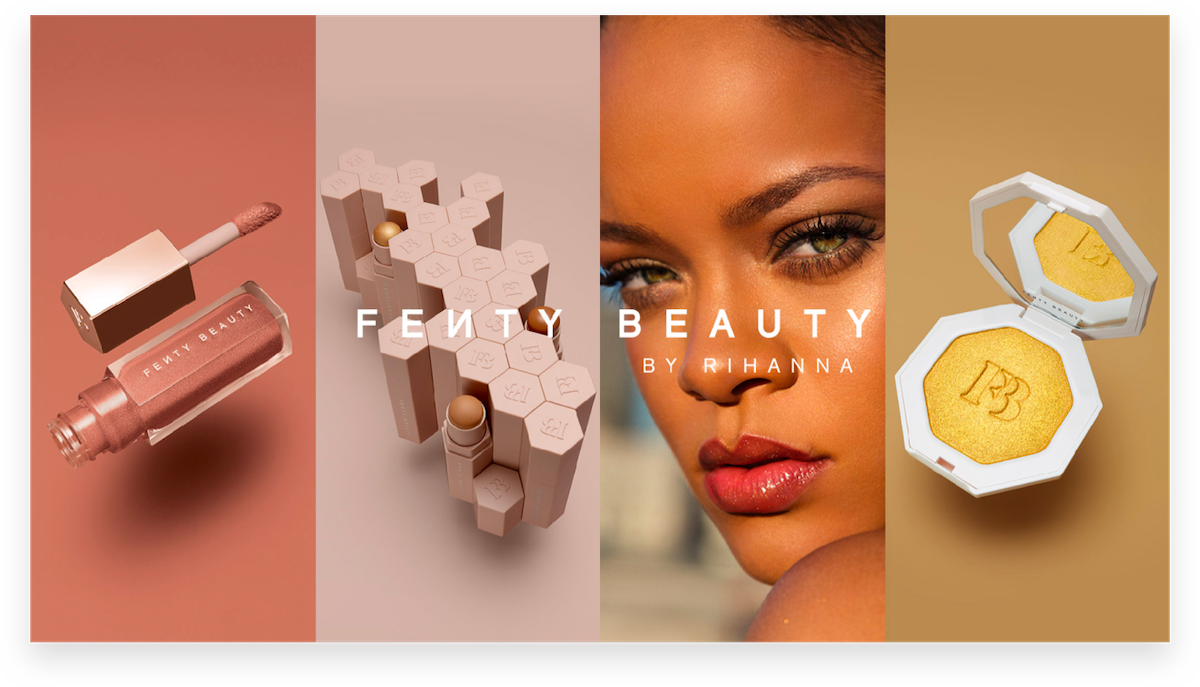
It reflects a sense that what used to be considered niche by archaic advertisers is no longer. Rather, it’s a wake-up call for marketers that diversity is critical to the expansion and service of all consumers.
4. KYLIE COSMETICS: INFLUENCE
The youngest-ever self-made billionaire. The 30-Under-30 list at a mere age of 19. Kylie Jenner is making history with her brand Kylie Cosmetics.
Reaping the benefits of hundreds of millions followers on her personal social channels combined with the business accounts, her success is a testament to the power of influencers on social media.
“It’s the power of social media,” Jenner told Forbes. “I had such a strong reach before I was able to start anything.”

Kylie was nurturing her social audience long before she ever asked them for the sale. By posting YouTube videos of her makeup routines and sharing looks on her Snapchat stories, she had positioned herself as a leading voice not only in beauty but also online fashion as well as health and wellness.

So, when the Kylie Cosmetics line launched, the lip-kits sold out in less than a minute. Her followers didn’t need any convincing. They were sold on the product because they were sold on her.
5. L’OREAL: FORWARDS, NOT BACKWARDS
More than a century old and a household name throughout its lifetime, L’Oreal is the leader in cosmetics sales worldwide.
Keeping the lead amidst decades of revolution in the beauty industry has required that L’Oreal doesn’t look back and revel in its status. Rather, they must constantly adapt the model to progress forward and keep up with DTC disruptors.
L’Oreal’s strategy: get out of the old (legacy) by integrating the new (technology). Its emphasis is on pioneering new technologies like AR, VR, and AI to bolster product discovery. They’ve even coined the shift to digital marketing strategies, “Marketing 3.0.”
A disruption not only within the company but across the beauty industry as a whole was its acquisition of AR beauty tech start-up, Modiface in 2018.
Beauty marketers worldwide quickly followed L’Oreal’s lead, with 65% expecting AI-powered conversation campaigns to be adopted at-scale by 2020.

“The game won’t be the same when you simply ask your voice assistant to buy the best mascara on the market for you. Or if you are able to watch a makeup tutorial directly on your face with a virtual try-on,” said Lubomira Rochet, L’Oréal’s global chief digital officer in a Think with Google interview.
“The brands that master these experiences will be the ones people choose.”
Strategy: Your Ecommerce Cosmetics Marketing Growth Plan
When growing a cosmetics brand from the ground up, only four metrics matter: visitors, conversion rate, lifetime value, and variable costs.
We call it the …
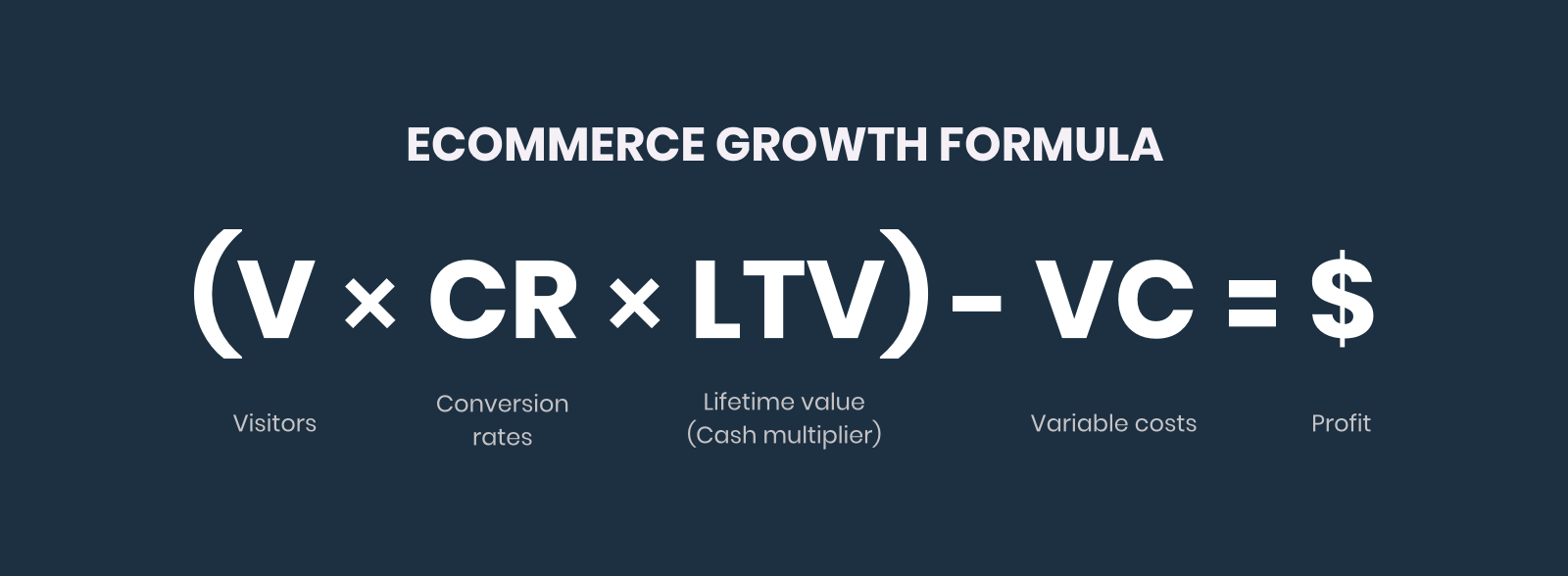
There’s no other way to increase your profitability than to affect one of these four variables — driving them forward through a strategy built for growth.
Visitors: Driving Traffic
Drive new and returning customers (your target audience) to your online store across every distribution channel available.
Social Media Advertising
Glossier named it the main reason for its success. Rihanna exclusively launched her brand on it. Social media marketing across Instagram, Facebook, and Twitter is the honey pot for modern beauty brands.
The numbers follow the trend:
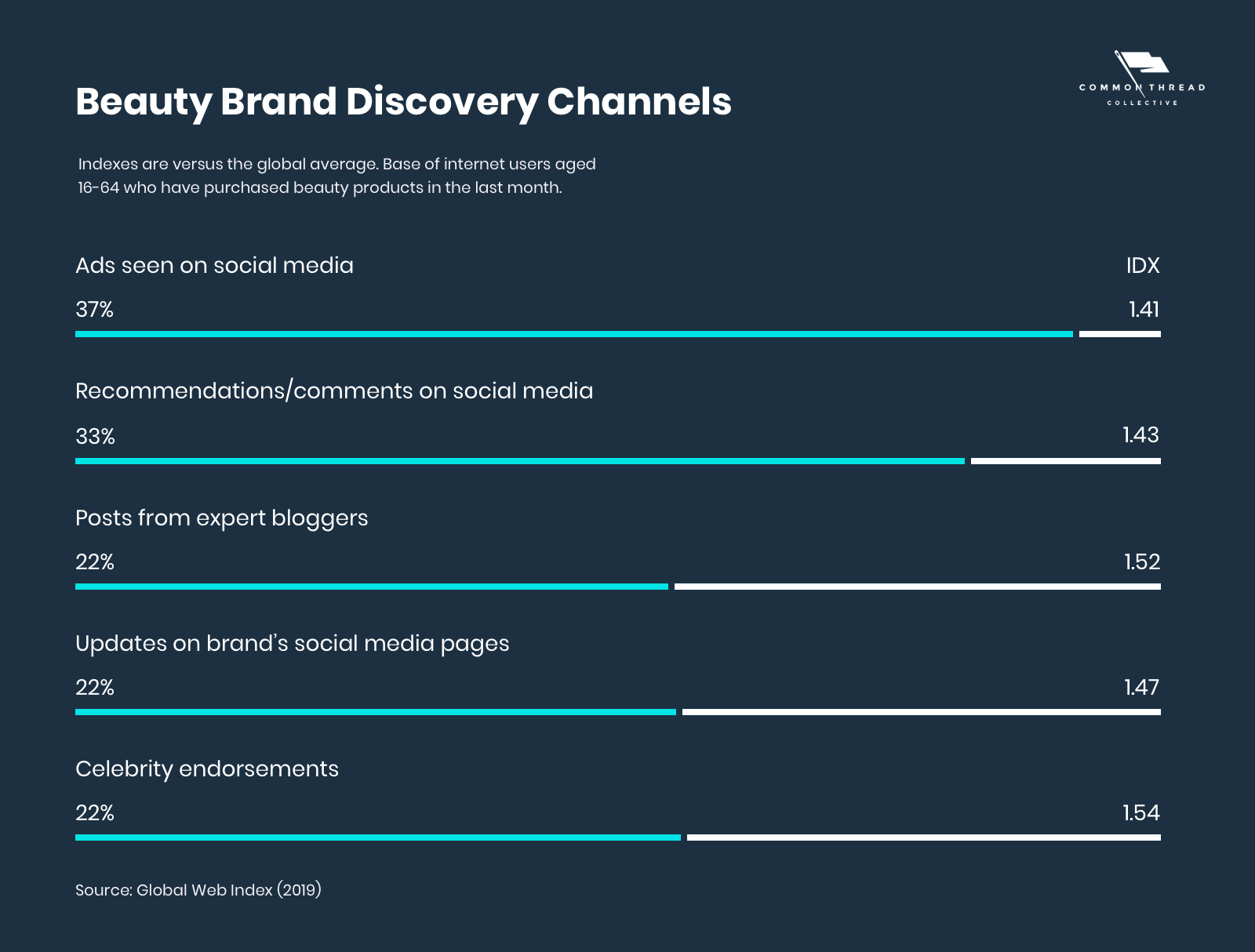
When running a cosmetics marketing campaign on social media, begin by determining what makes your product visually intriguing. Then, test that out in your ad creatives.
“When selling a product like a moisturizer, showing an application photo isn’t that interesting,” says Vincent Wu of Bambu Earth.
“Instead, we started shooting photos of the jar angled onto the top of the product. We messed with the product textures, lighting, props — and have found ad success with it because of the unique creative display.”
After using the right side of your brain, don’t forget about the left — develop a social media buying strategy. Start by calculating your numbers by examining customer cohorts:
- What are people doing post-purchase?
- Are they coming back?
- If so, how many and how long does it take?
Then, utilize this data to come up with a spend strategy that aligns with your cash flow and goals.
Influencers
The advantage cosmetic brands have compared to other industries, is that influencers can showcase results in real-time.
What used to be walking through malls with associates applying makeup samples for free, is now replaced by bloggers doing live social media tutorials that demonstrate the results and what they like about it.
With cosmetics products especially, use video. It’s easy to fake affinity for the product or brand through a still image or written copy. By having the influencers create video content — the authenticity, or lack thereof, will be clearly seen.
The numbers back it up. With a majority of beauty content consumed coming directly from influencers instead of brands, it’s indicative that building trust through social-proof can impact buying behavior.
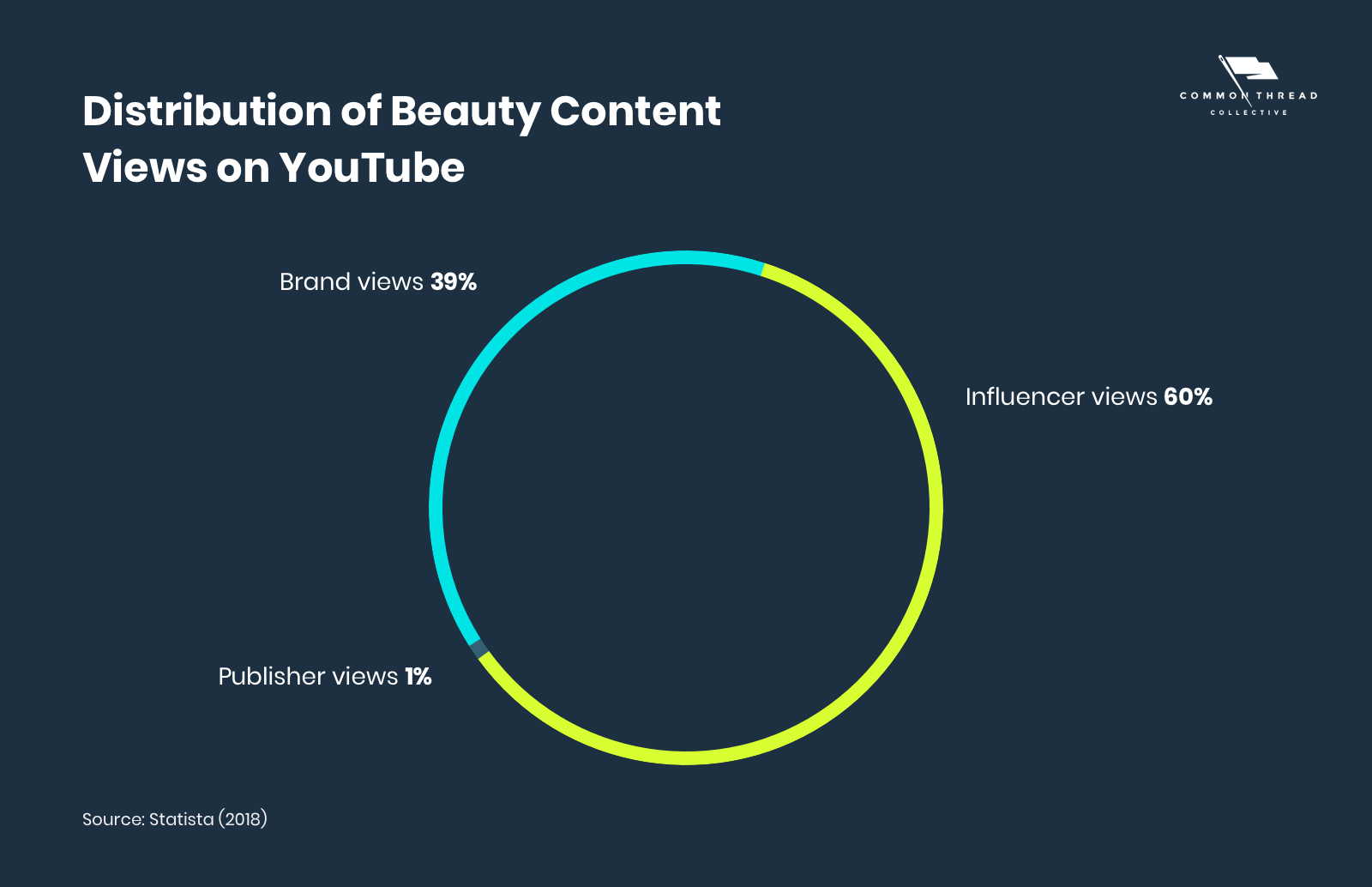
“Cosmetics brands should aim for creating YouTube tutorial content that shows the results of the product,” says Cody Wittick of Kynship, an influencer marketing agency. “Include influencer testimonials, such as ‘this product made me feel [blank]’ or ‘I loved this about it.’”
“Aside from social media, a marketing tactic that often gets overlooked is the unboxing experience that you can create for influencers,” says Wittick. “Fabfitfun created a stir about this, yet it’s a tactic that still gets neglected.”
Create a great first impression with the influencer by sending something special to them. If you don’t have the budget, write a handwritten note. Personalizing the experience will increase affinity and the resulting content will reflect that genuineness.
Search Engine Marketing (SEM)
Google Shopping campaigns always were and will continue to be the most important campaign type you can leverage as an ecommerce brand.
Within Google Shopping, the biggest focus for brands within the cosmetics vertical is rock-solid data feed management.
As opposed to normal search campaigns, Google Shopping campaigns do not use specific keyword targeting. Instead, ads are targeted using the data in your customer feed. Google has a long list of specifications that explains which data they need and in which format they need it in.
While there’s plenty of data you can send Google in a feed, not all fields are created equal. Certain optimizations will have more of an impact than others, with product title being the most important.
“We like to get as much information into the product title as possible within the 150 character limit,” said Common Thread Collective’s Director of Paid Search, Tony Chopp. “And typically we like to follow some sort of structure to keep things consistent, for example:
- Brand + Product Type + Color + Material
- Brand + Size (length, width, height) + Product Type + Color
- Material + Product Type + Color + Brand
- Style + Color + Product Type + Brand
- Product Type + Size + Color + Feature + Brand
Think about how you can get potential non-brand search keywords into your products. And mind the order. Google places more weight on words at the beginning of the title than those towards the end.
Search Engine Optimization (SEO)
When combining organic with paid marketing campaigns, the potential for growth skyrockets. Still, revere owned media channels to generate returning customer value, not as your source of new customer acquisition.
Build personalized email flows. Create useful blog content. Cherish your organic audience and reward them for continually choosing to engage with you.
YouTube
The leading content category among women and a fanbase of millions – beauty has taken YouTube by storm.
From skincare tutorials to cosmetics hauls, the platform is ripe for both entertaining and convincing new buyers.

The best part? Legacy beauty brands aren’t dominating.
Their content makes up 3% of total views, while individual “vloggers” control a stunning 97% of all beauty videos (DigitalSurgeons).
Startups looking to capitalize on the massive space must utilize the power of influencer marketing.
One of the most famous faces on both YouTube and in the industry is Jeffree Star. The vlogger has built such a frenzy around his personal brand, that following the launch of his own make-up collection, the hosting Shopify site went down within minutes of kickoff due to extremely high shopping volumes.
The recipe for his content success: immersive tutorials that build excitement around a product to ultimately sell and make money. Star even managed to make the list of the highest-earning YouTube stars in 2019 across all content categories, with estimated annual earnings of 18 million US dollars.
His influence, among other YouTube stars, is a testament to the way that consumer buying behavior is changing significantly and likely for the foreseeable future.
Data from CTC’s clients across the cosmetics industry show that store visits are down by more than 90% and YouTube views are up by 20%.
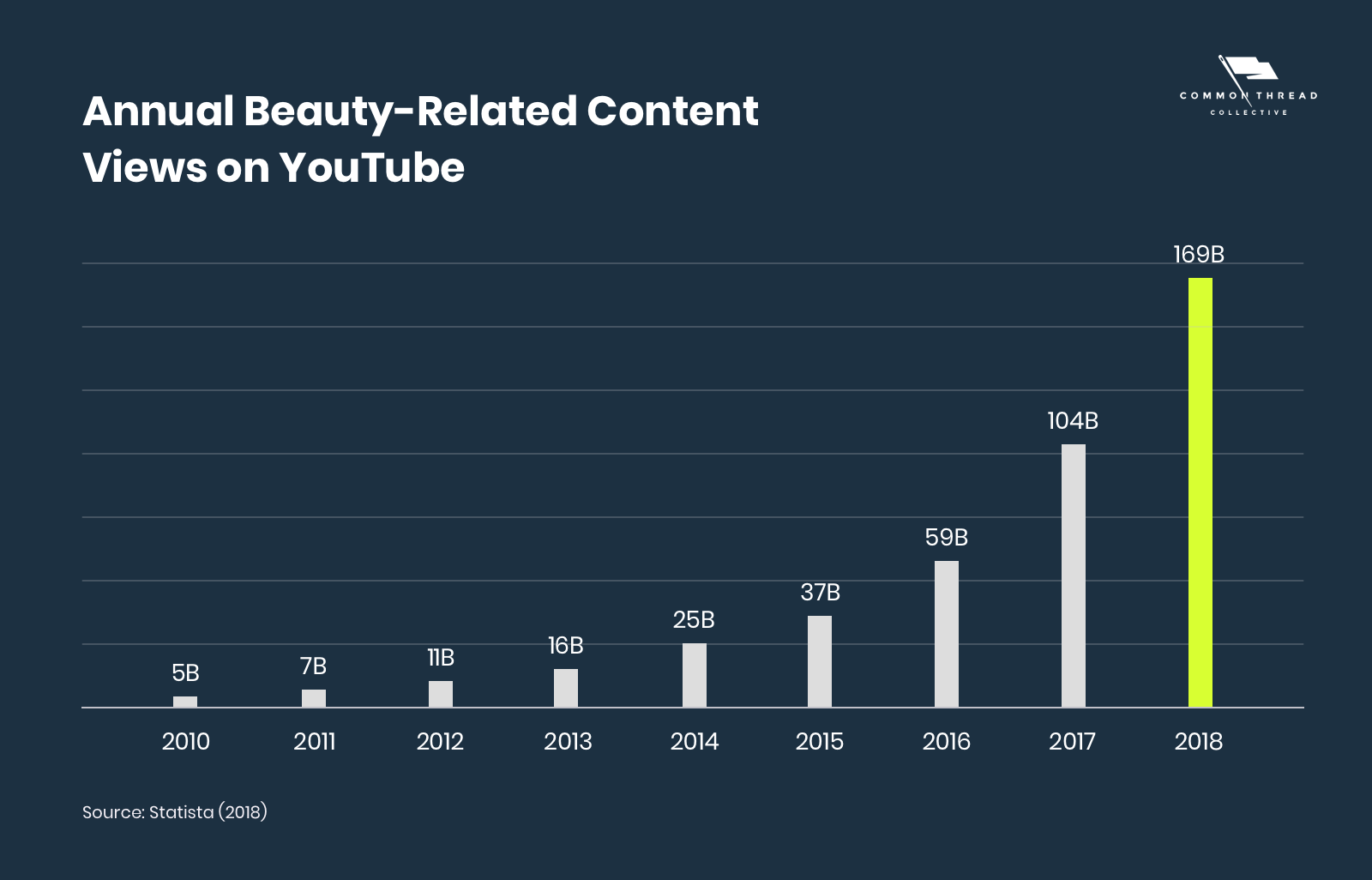
As a result, YouTube campaigns offer affordable awareness and profitable conversions.
Still, it’s worth considering how you measure the success of your YouTube campaigns. Typical attribution setups in Google Ads do not directly report on view-through conversions, but you can analyze them by looking at the “All Conversion” reporting columns.
“We often measure YouTube (and Display) differently than traditional search and shopping campaigns, by at least considering a 1-day view through window,” recommends Chopp.
Conversion Rate
Acquire new customers and increase AOV by optimizing your onsite experience.
From driving visitors through ads to the design experience, conversion rate encompasses the culmination of digital marketing efforts within your sales funnels to finalize a purchase.
Tactics to increase conversion rate include email capture, reviews, trust seals, user-generated content, subscriptions, and in-cart or post-purchase upsells. This combined with site speed and mobile optimization allows for a seamless shopping experience.
Customer Lifetime Value
To build your business over the long term, the most important and often overlooked metric is your LTV or “cash multiplier” (CM). Rather than thinking about your entire lifetime of your business, we want to know what your customer is worth in a very specific payback period.
Start by determining your 30-, 60-, or 90-day LTV. Then, execute a plan that fits your cash flow and builds your business over the long term. Tactics like memorable unboxing experiences or content marketing can generate an organic community of brand evangelists.
Email Marketing
Retention, retention, retention. Email marketing is critical to improving your LTV and maximizing revenue.
The good news is, we’ve already laid out the strategy to drive visitors to your site. Use their arrival to your advantage by encouraging subscriptions to your email lists, which will drive purchases further down the line if they don’t convert the first time around.
Whether your email subscriber is a future or past purchaser, mix two parts education and engagement with one part sales.
Drivers like loyalty or subscription programs are tactics that build a community around your brand and lead to upsells further down the line.
From welcome flows to post-purchase flows, ensure your messages speak to your brand and provide value to your consumer’s stage in the customer journey.
Variable Costs
If costs increase as orders rise, that’s a variable cost.
Opposed to fixed costs — like rent and operational overhead — VCs cover COGS, platform and payment processors, supply chain, fulfillment, and CAC: total spend including agency fees.
Cosmetics brand looking to measure and optimize variable costs, should opt to follow a four-quarter accounting matrix. Each represents a portion of your revenue that signals the health of that component as well as areas of opportunity.
Case Studies: Growth Lessons from Three Cosmetics Brands
ColourPop Cosmetics

THE BRAND
Indie beauty brand, ColourPop Cosmetics, was founded in 2014 by siblings Laura and John Nelson. From there, the entire business grew organically, beloved for its affordable color cosmetic products.

With strong traffic and conversions coming from its limited-edition collaborations, the digitally native brand was content in keeping the organic momentum going.
Until, organic wasn’t enough.
THE CHALLENGE
Available exclusively online and in Ulta, its focus was on catching customer’s attention on social media instead of market shelves. But, for a brand that was born organically on social media, it hadn’t paid any attention to paid social media efforts.
Neglecting this category in its business strategy, meant missing out on new visitors and higher returns since it lacked in-store discoverability. In order to grow and scale digitally, paid ads were the necessary next-step in its maturity.
THE STRATEGY
Boost visitors. Increase returns. Build ROAS.
To do so meant amplifying ColourPop’s message to new prospecting customers by running conversion objective campaigns on Facebook.
A focus on conversions rather than awareness was strategic — the creative showed why the product was valuable, while the buying methodology to get that creative in front of an audience encouraged customers to take action on site.
The product was self-explanatory. Finding a way to show that it was still high-quality relative to the lower price point, was the creative unlock for the brand.
One messaging angle involved running ads about duped colors to its competitor audiences, who were selling similar products at higher markups.

“The biggest contributor to success lay in our ability to make ColourPop stand out in a competitive market, without blatantly calling out the price of the product on the ad level,” said Growth Guide, Michelle Luo.
“Instead, we opted to show the product in use, so that you can really see the quality and color payoff of the products.”
After price, the major wins were ads that highlighted product quality. Whether it was up-close videos of putting lipstick on and not seeing it crack or user-generated content – the advertising focused on the color payoff and how good the product looked.
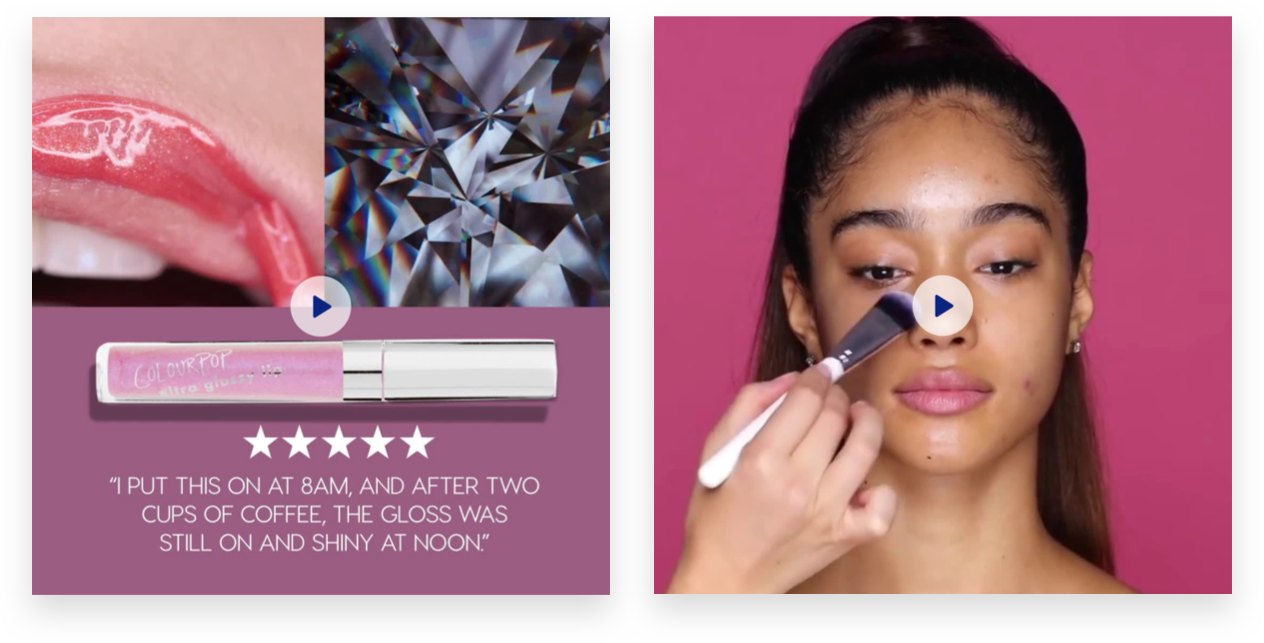
“It didn’t matter if the ad was pretty,” said Luo. “It mattered that it showed real people using the product.”
A website optimized for conversion rate completed the holy grail. By capitalizing on its audience with new creative and running conversion campaigns to get them onsite, it was the perfect trifecta to ensure purchases.
This culminated with ColourPop’s collaboration with Disney. Each princess launched her own makeup collection featuring limited edition products.
Thumb-stopping creative run to a Disney audience, the ad campaign smashed, with a 15x return on 1-day-view, 1-day-click.
It was so successful that it capitalized by following up with a Disney Villains make-up line, reaping in wicked returns once again.
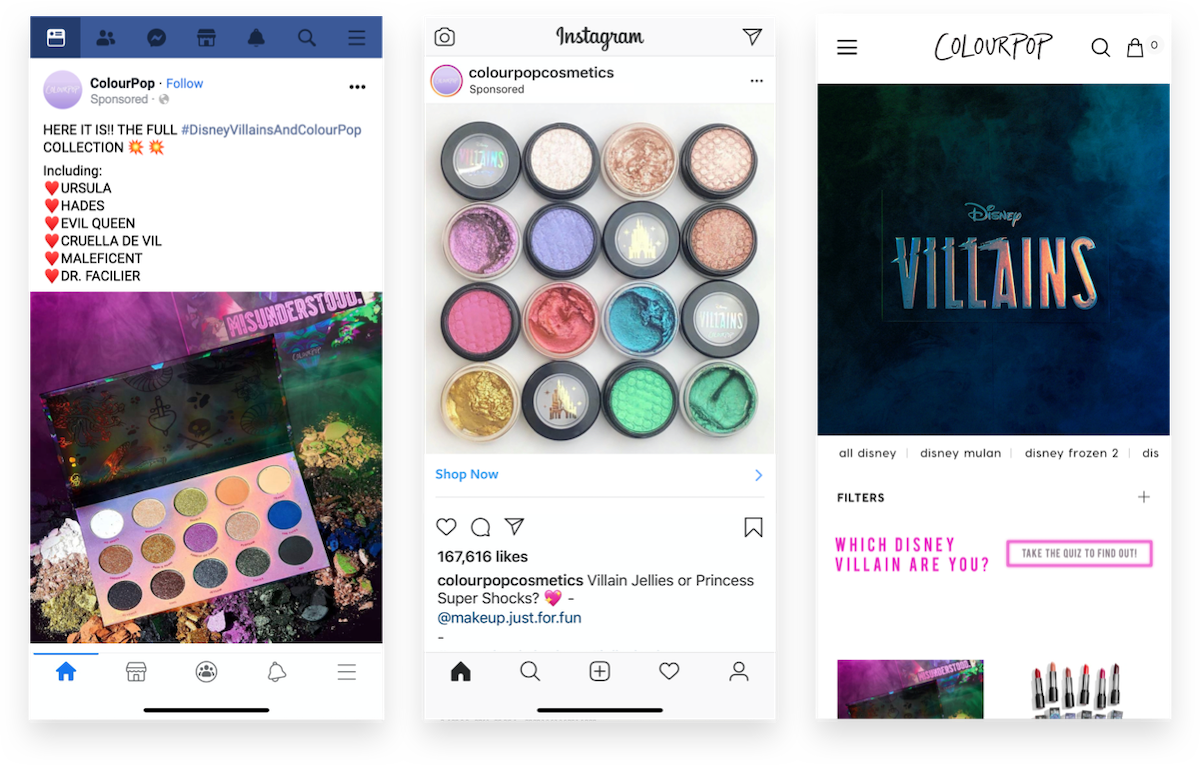
THE RESULTS
- 5x return on prospecting campaigns
- 7.5x return on remarketing efforts
- 15x return on Disney campaigns
Bambu Earth

THE BRAND
Bambu Earth is a clean-beauty brand that takes a holistic approach to skincare using all-natural products to restore skin to its natural state.
Amber Hawthorne founded the business over ten years ago, and in early 2019 was acquired by 4×400 — Common Thread Collective’s (CTC) in-house holding company that acquires and builds digitally native brands.
A win for everybody involved … until it wasn’t.
THE CHALLENGE
For the first few months, Bambu Earth struggled.
It was all the things you expect … low traffic and dismal conversion rate that no new creative or better-performing ad could fix.
And the reason was simple: they just weren’t converting enough customers (a 2.14% conversion rate at a $64 AOV just won’t cut it), which meant they couldn’t afford to drive more traffic.
First, Bambu Earth needed a brand refresh, both visually and conceptually. So we rebuilt the website and clarified the brand pillars that were true to the core of Amber’s long-held commitments to her customers.

From there, it needed new advertising that reflected that. Some new UGC and reshot product-focused imagery started to fuel real growth.
“Suddenly it was on the cusp of rocketship growth,” says Andrew Faris, CEO of 4×400 “and we could feel it. We just needed that one big push to really get us over the edge.”
At a start-up stage in its business, increasing every lever for growth ultimately matters for Bambu Earth. Yet, while it’s always iterating on driving and converting traffic that will affect AOV — because it’s a consumable product, lifetime customer value is the game.
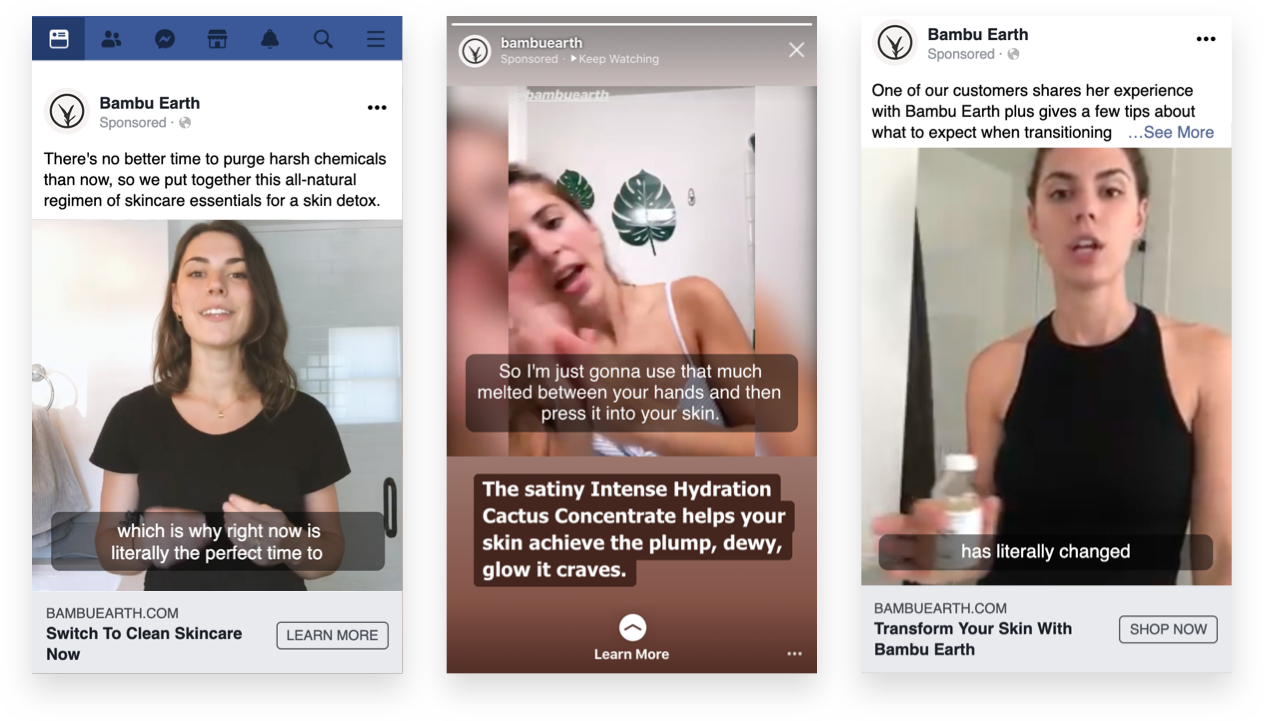
The team knew that customers who converted stuck around. So they had to do two things: solve the conversion rate issue, then validate the LTV assumption.
THE STRATEGY
“LTV is the thing that has and will continue to turn Bambu Earth into a huge player on the cosmetics scene,” says Faris. “At its core, we believe that’s possible because the product is so strong.”
Knowing its products’ strengths sets up the brand strategy to focus on increased spending of marketing dollars relative to its top-line revenue (and feel really good about the outcome).
It all starts with tracking LTV by first-product-purchased.
“If you don’t know what you’re trying to track, you will never get good,” says Faris. “I think this is a really underestimated step, is that you can’t really do a great job strategically without having the information on hand from the start.”
For example, if LTV on a moisturizer is strong, yet costs the brand a significant amount to acquire that customer in the first place — being a startup, Bambu Earth can’t front the cash flow over the long term for it to be worth it to the business.
On the other hand, if the LTV is not as strong on the toner, but Bambu can acquire that customer really cheaply — there’s profit to be made earlier.
While LTV is the main variable at play, the lesson is that you have to do that relative to the cost of acquiring the customer in the first place. This prep work isn’t complete without factoring in the margin to determine where the cost value is.
Within that, a singular strategy emerged to solve for LTV: a skin quiz.

When visitors arrive, they’re kicked into a quiz on the homepage with questions about their skin health, lifestyle, and goals. After finishing the quiz, customers are then given a custom product recommendation based on their results.
Retention first and foremost is about having a great product that actually works for people.
“We want to make sure that we set people up for success,” says Faris. “We utilize the skin quiz as a way to serve our customers well by giving them a product they’ll love, which creates value for us because they want to keep coming back.”
Building on LTV doesn’t stop there. It means hammering away at every element:
- The quiz itself
- The landing page
- The ads that drive visitors
- The post-purchase email flow
The team has personalized things even further. First, by adding customer service options relative to where visitors land. Second, by tracking what questions people ask about each kit and then putting those answers on each product page
Ultimately, it’s about developing a full-funnel approach to acquisition and retention … as opposed to just an ad strategy. It allows Bambu Earth to (at-scale) walk people into the best product for them and then sets the brand up to address that.
THE RESULTS
- 25x revenue YoY (and is now a profitable business).
- Customers who purchase through the quiz 2x value within 90 days and 2.5x AOV within 90 days.
- For the month of February 2020, Bambu Earth had earned as much revenue from returning customers only as it did in total customer revenue overall for 2018.
Coola

THE BRAND
The Coola brand is the quintessential slice of California life and its products embody that ethos — from organic wellness to an outdoor, active lifestyle. Its skincare products are eco-conscious and sourced with a “farm to face” philosophy.

CTC caught Coola’s drift and set out to achieve its goal of protecting and improving skin, utilizing paid media to increase purchases of its organic sun-care products.
THE CHALLENGE
In the beauty industry, getting customers to your site doesn’t always come cheap. With CPMs for paid traffic higher than most, the difficulty is increasing visitors without breaking the bank.
Coola was no exception. As a brand that wasn’t digitally native, the hurdle was gaining traffic online, not just in-stores. With a significantly high conversion rate, the opportunity was there.
The goal became getting qualified traffic to the site for a lower cost.
Alongside the obstacle of increasing visitors, was increasing AOV and LTV.
Before launching its paid media campaign, the CTC growth team conducted analysis and found that certain Coola products had higher AOV on Facebook (people would tend to bundle them with other products) at the top of the funnel.
As customers went down the funnel, they’d tend to buy more.
To capitalize on this meant finding ways to increase repeat purchase rate and the lifetime value of the customers that it was actually driving.
All that was left was to test it.
THE STRATEGY
To combat high CPMs, it all came down to the creative and the angle of ad messaging.
For example, one of the top products for Coola is its “Sunless Tan” — but the challenge became adjusting the ad messaging angle during each season to produce creative that converts year-round.
In the winter, the focus was on keeping a bronze glow all year. In the summer, the messaging was about accentuating your current tan with the product.
To increase visitors, the team tested different creative variations for advertising — from still images to long-form makeup tutorials on YouTube. Through creative testing, they found a balance.
From a prospecting standpoint, long-form YouTube videos that showed people applying the product and illustrating its core benefits resulted in enticing content with a native-feel that led to engagement.
Then in remarketing, the team focused more on the actual product itself, with gifs and still-image product photography to further inform the consumer.

After identifying winning creative combinations by marketing campaign stage, the team then began hyper-targeting audiences. This strategy went against the grain of CTC’s typical buying methodology of targeting broad audiences, but it was because of one important caveat …
The Coola product catalog is diverse, from lip balm and sunscreen to aging serums and BB creams.
“Instead of our normal broad prospecting and remarketing, we built specific funnels around key products that demonstrated high AOV,” said Growth Strategist, Andy Reese.
“Whether it was the sunless tan collection or the aging serum — each diverse product had its own funnel from top-to-bottom, so we could hyper-target those interested.”
By selling through individual product funnels, Coola offered customers the niche products they actually needed — making them more likely to convert — instead of putting them into a standard remarketing audience where they’re getting ads for products they didn’t show interest in.
This became a layup for improving lifetime customer value. “We know that the replenish rate for the sunless tanner product is 60 days,” says Reese. “So anywhere from 45-60 days after they’ve purchased, to impact LTV, we’d target them with an ad to remind them to re-up on their product purchased.”
Running recent-purchaser campaigns by product funnel increased Coola’s repeat purchase rate by over 50%
It wasn’t just ecommerce that was reaping the benefits. Coola saw the results of Facebook advertising come through on other channels.
After running paid ads, there was a surge in in-store purchases of Coola products within retail locations at Ulta and Sephora. Digital strategy positively impacted the business holistically.
THE RESULTS
- 140% YoY growth
- +50% lift in repeat customers
The Right Partner: Do You Need a Cosmetics Marketing Agency?
After growing brands like ColourPop, Coola, Bambu Earth, and more we pride ourselves on being growth experts in every stage of the online sales process within the cosmetics market space.
From creative content to media buying, our solutions are specifically tailored to tweak the variables that create revenue.
Last, don’t forget to grab all the data, tactics, and case studies in one fittingly beautiful PDF:

This article is part of our larger series on ecommerce and online verticals. If you’re interested in more, you can download reports for each:
- 10 Ecommerce Trends for 2020: The Future of Direct-to-Consumer (DTC) Retail from 17 Leaders in a ‘Post Acquisition’ World
- Health & Wellness Marketing: An Ecommerce Report on the Personal Care Industry, Trends & Strategies for Growth
- Pet Industry Growth, Statistics & Trends 2020: A Definitive Ecommerce Marketing Report
- Fashion Ecommerce in 2020 and Beyond: A Special Report on the Data & Trends Shaping Growth in the Online Apparel Industry

